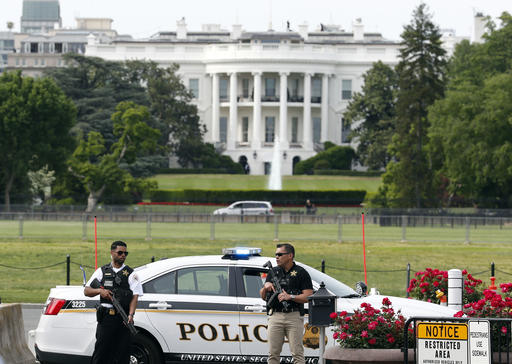
Law enforcement personnel stand near the Ellipse south of the White House on Constitution Avenue, Friday, May 20, 2016, in Washington. AP FILE
WASHINGTON — After so much winning, Donald Trump and his team are walking into the White House with a swagger. But the realities of life at 1600 Pennsylvania Avenue are about to bite.
Forget the thrilling roar of Air Force One, or the world-destroying power of the nuclear codes. Seen from inside the White House gates, the presidency is more like a beat-up megaphone than a font of boundless power.
If a president is lucky, only a third of Americans will hate him. World events and vested interests will yank him hither and thither and politics will bind every move.
Congress can look more like a playground full of toddlers screaming and biting their way to the top of the slide, than allies fighting in common cause.
Trump enters the Oval Office with a 48 percent disapproval rating and a world that looks more complex and dangerous than it has in decades. He leads a Republican Party riven by ideological disputes.
All that would be daunting enough. But, as one former White House official recalled, the hardest thing for a new president can be closer to home — deciding how to decide.
‘Decision points’
Every day the commander-in-chief and roughly 470 White House staff make countless choices that shape the administration.
Even the most mundane can have lasting consequences: will a legislator be irked without an invite to a bill signing? Will “POTUS” go home after visiting Egypt or stop off in Israel on the way?
Facing monumental decisions, Dwight Eisenhower — the last non-politician to take the Oval Office — liked to see a ferocious battle of ideas played out in front of him before coming down either way.
Ronald Reagan disliked witnessing rows, instead delegating decisions and leaving aides to scramble for access and influence one-by-one.
“It’s hard to tell what to expect from Trump because he’s had so little policy experience and he’s obviously got a mercurial personality,” said Fred Greenstein, professor emeritus at Princeton University and author of “The Presidential Difference: Leadership Style from FDR to Barack Obama.”
During the transition, Trump has often made decisions on impulse, catching even his most senior advisers off guard.
He has reversed decisions on top-level appointments and rolled out sensitive policy reforms — like an overhaul of veterans’ healthcare — on the fly (sometimes before considering legislative hurdles).
Trump’s inner circle saw some tweets percolating for days before being unleashed on an unsuspecting world. But some 140-character-missives were a surprise even to them.
Trust the process
Trump, a CEO-turned-commander in chief, has turned to a disparate group of family members, generals, billionaires and establishment Republicans — few of whom have any White House experience — to help him run the United States.
Such a variety of views can be constructive. Abraham Lincoln famously gathered a “team of rivals” that guided America through the Civil War.
Reagan’s team of rivals settled on a division of labor. “He had this very interesting triumvirate of people: (Edwin) Meese, who was sort of the ideologue; Jim Baker, who was the practical politician and the establishment Republican, and Mike Deaver, who was a PR man and was very close to Nancy. They didn’t so much argue as handle different facets of Reagan’s leadership,” said Greenstein.
But rivalries can also split the house asunder. The West Wing is small, but it can produce discontent, envy and ambition in doses worthy of Shakespeare.
Turf wars between George H.W. Bush’s chief of staff John Sununu and budget director Richard Darman fueled damaging leaks and a battle over taxes that helped make him a one-term president.
At the core of George W. Bush’s inner circle were two veterans of Gerald Ford’s administration, Dick Cheney and Donald Rumsfeld, who turned influence into an art form.
“The process of moving paper in and out of the Oval Office, who gets involved in the meetings, who does the president listen to, who gets a chance to talk to him before he makes a decision, is absolutely critical,” Cheney said before he was elected vice president. “It has to be managed in such a way that it has integrity.”
In office, Cheney often hung around after others had laid out their arguments. “Who spoke to the president last?” became a crucial question that would ultimately help nudge Bush into the Iraq war.
One former White House official said it was too difficult to predict how Trump’s White House will manage the process: “I don’t know that they know yet.”
Could Trump’s daughter Ivanka sit in on cabinet and other top meetings like President Jimmy Carter’s wife Rosalynn, or wield policy influence like Eleanor Roosevelt or Hillary Clinton?
Will Trump delegate policy to mainstream Republicans like chief of staff-designate Reince Priebus and Mike Pence, making the latter the most powerful vice president since Cheney?
Could aide Kellyanne Conway, Ivanka’s husband Jared Kushner or hard-right ideologue Steve Bannon be the last person in the room?
Will retired Marine Corps generals tapped to run the Pentagon and the Department of Homeland Security — and their comrade, the sitting chairman of the Joint Chiefs of Staff, General Joseph Dunford — come together in a powerful cabal?
Trump will have to choose wisely if he wants to avoid chaos and walk around the White House with the same swagger he has coming in. CBB/rga